My pleasure Booger!
Draft Papst Blue Ribbon 25oz Ice Cold Mug!!
🍺🍺🍺
Draft Papst Blue Ribbon 25oz Ice Cold Mug!!
🍺🍺🍺
Last edited:
Why not move the driver down to fix the 3 Fb issue ? This is soooooo helpful and drops right into 3 folds, lightly stuffed to polish the sound, to the ‘perfect’ scenario to work with.
L12 is ALWAYS [pi/9 x total length] in this MLTL layout folded/excited at ~~~ the node/antinode Of the 3 Fb harmonic Point(s) along the way.
You do know that alt+print screen is a thing? Then you take a picture of the currently used program only.I posted an app for him to capture the screens
Somehow, I don't think you are.Sorry about the jizz
So activating snip & sketch tool through windows key+shift+s was not working?
alt+print screen is still faster though, if you want to paste many pictures into mspaint.
alt+print screen is still faster though, if you want to paste many pictures into mspaint.
You don't need to press Ctrl with Lightshoot just printscr key,plus it have some more functions that snip don't have, is very handy. I like it and recommended to Booger and he's a happy camper 🙂, there are many variations of the theme, is matter of personal taste.
How do you like your eggs kind of thing 🤪
How do you like your eggs kind of thing 🤪
I'll check it out, doubt it's quicker than alt+print screen possibly alt+tab to mspaint and ctrl+v to get all of them in a single fil, but we shall see.
Just had a look at Lightshot, it may be somewhat better than snip & sketch tool in Windows as it seems to be slightly more responsive and easier if you want to scribble on the picture, both are slower than alt+print screen by far.
If there was a way to compile several images into a single file without using another program like mspaint then it would be much better, the biggest difference between Lighshot and snip & sketch seems to be: For Lighshot you have to press ctrl+c before you have the picture in clipboard vs the snip & sketch you have it immediately in clipboard after marking the area.

VS

If there was a way to compile several images into a single file without using another program like mspaint then it would be much better, the biggest difference between Lighshot and snip & sketch seems to be: For Lighshot you have to press ctrl+c before you have the picture in clipboard vs the snip & sketch you have it immediately in clipboard after marking the area.
VS
From this simulation we can see 3dB lost in the low range, so we Can't say this is an improvement, it might be a trade-off, you loose SPL at lower frequency to reduce the amplitude of the spikes in the upper range.
It's also important to check if the simulated numbers can be translated into a real box dimensions / geometry and we can do that with FreeCAD models.
Reducing the cross section area in the last segments helps to damper things, but it will increase air speed,
The opposite is how ground effects work with racecars!
Who's watching the Daytona 24 Hours this weekend???
And paste screenshots directly without using your cell, you save more hassle.
It's quick and fast you just
press the printscr key
Select the area of hornresp with the mouse
Select copy from the side menu
Select your DIY forum post
Press CTRL-V and Voila!!
Instant eye candy!
Too many steps.
As long as your cursor is in the window you want to copy, just use the:
Alt + PrtScn keys.
Paste with right click mouse or Ctrl + V keys.
I can't type, so I use what is most efficient (BP's 4 Life).
I hear you, but that is not my cup of tea
i like to select my capture area
or do some annotations or else that's why i like lightshot
there are several apps that do similar stuff as i already said
but i am used to that one.
at the end is not the bananas but the monkey.
i like to select my capture area
or do some annotations or else that's why i like lightshot
there are several apps that do similar stuff as i already said
but i am used to that one.
at the end is not the bananas but the monkey.
Standard ODMLtl using Martin Kings 2 decade old (?) tables. ‘Improvement’ is not ‘SPL’, it’s a flat/damped response to 5•Fb in reality. (Not including the 0.75 Fb drop from the mass loaded last fold?) undamp it and/or tune it higher if you want ‘more SPL’ ...From this simulation we can see 3dB lost in the low range, so we Can't say this is an improvement, it might be a trade-off, you loose SPL at lower frequency to reduce the amplitude of the spikes in the upper range.
It's also important to check if the simulated numbers can be translated into a real box dimensions / geometry and we can do that with FreeCAD models.
swap the driver, Add some filter/dsp? B&c 18 ds 115-4 bolts right up in 5 minutes. Dayton Umax18 rings(heavy cone, lower Qes)
@ 18 ds 125-4, Shorten it to 104.72,100,95.28 cm and ~900,900,450 cm2 @ ~21.6 hz(I use this length for dayton rss265ho4 in an appropriately skinnier 300,300,150 cm2)
69.81, 66.66, 65.53cm … ~32 hz And so on
Attachments
-
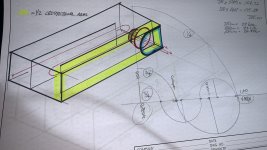 7F301E74-A265-420B-8156-3294A70ACB7A.jpeg431.7 KB · Views: 56
7F301E74-A265-420B-8156-3294A70ACB7A.jpeg431.7 KB · Views: 56 -
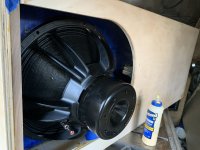 A948A992-16CB-47EE-AE9B-10EEA2F91D89.jpeg382.5 KB · Views: 55
A948A992-16CB-47EE-AE9B-10EEA2F91D89.jpeg382.5 KB · Views: 55 -
 BEE9D468-E339-4D45-A23B-6FCEA4B08F82.jpeg397.2 KB · Views: 55
BEE9D468-E339-4D45-A23B-6FCEA4B08F82.jpeg397.2 KB · Views: 55 -
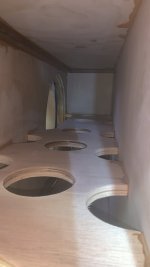 D11F34D1-E7CC-4D55-AEF0-8C03DFD1C415.jpeg131.6 KB · Views: 53
D11F34D1-E7CC-4D55-AEF0-8C03DFD1C415.jpeg131.6 KB · Views: 53 -
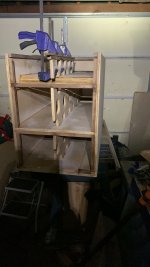 2ED48A68-0DBD-4DBC-8661-D74A967BF83C.jpeg407.2 KB · Views: 54
2ED48A68-0DBD-4DBC-8661-D74A967BF83C.jpeg407.2 KB · Views: 54 -
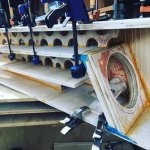 332EED7E-6CD0-4D09-868C-8EF7EDEF016B.jpeg137.7 KB · Views: 60
332EED7E-6CD0-4D09-868C-8EF7EDEF016B.jpeg137.7 KB · Views: 60 -
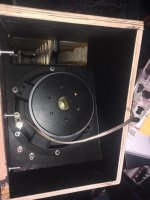 2E6AE11B-9872-44D3-A636-2A3E397606DB.jpeg74 KB · Views: 55
2E6AE11B-9872-44D3-A636-2A3E397606DB.jpeg74 KB · Views: 55 -
 B1C75147-F606-4EAB-ABB1-B85C69ECD852.jpeg51.7 KB · Views: 60
B1C75147-F606-4EAB-ABB1-B85C69ECD852.jpeg51.7 KB · Views: 60
Last edited:
example 200cm (43.2 hz). Is split @ 200x (0.349 or pi/9) as 69.31cm, 66.66cm and 63.53cm … To exit (200 total). once damped, and or corner, loaded this line’s up perfectly as described, formerly in Martin Kings tables for transmission, line, offset and reduction ratios. Apparently It’s a combo of end correction and line split at acoustical center from the closed end of any pipe as this works perfectly for positioning, the hot/ cold/damped source in a thermal acoustic engine using glass test tubes or similar too(an exciting experiment to do too!!) .
66.66 cm is 129.6 (hz ( 3•Fb harmonic void is now filled)
43.2(x0.75) is ~32 hz , as a result of the 50 % cm2 reduction. Of the last of 3 folds. The CSA is far from the air speed of a ‘typical’ bass reflex port, or this TL is a hybrid of both…. I dunno, but I like these as well as the higher order version if the TS parameters will allow
66.66 cm is 129.6 (hz ( 3•Fb harmonic void is now filled)
43.2(x0.75) is ~32 hz , as a result of the 50 % cm2 reduction. Of the last of 3 folds. The CSA is far from the air speed of a ‘typical’ bass reflex port, or this TL is a hybrid of both…. I dunno, but I like these as well as the higher order version if the TS parameters will allow
Higher order qw pipe version is just moving the exit to the location of that 3•Fb harmonic in a parallel pipe that incorporates both sides of the driver, fired from each end, or or moved away from it, to smooth out any response ripple (if/as needed) at the same location (3Fb resonance over excited, or driver happier at that affectingly lower pressure zone from the closed end ??? )
funstuff!!
funstuff!!
- Home
- Loudspeakers
- Subwoofers
- Furysub, Apache H15, or Jbell 2' cube